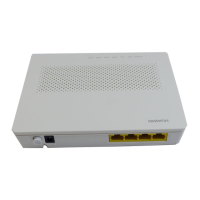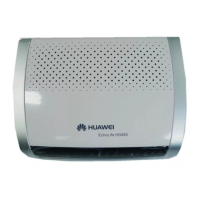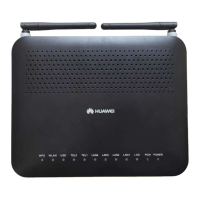Do you have a question about the Huawei EchoLife HG8010 and is the answer not in the manual?
Introduces the appearance, ports, and LEDs of the GPON terminal models.
Describes common network topologies and use cases for the GPON terminal.
Fundamental requirements for device storage, installation, and handling to ensure safe operation.
Guidelines for placing and operating the device in suitable environmental conditions.
Instructions on using accessories and handling the device during operation.
Procedures for safely cleaning the device's exterior.
Guidelines for proper disposal of the device and batteries.
Provides common methods and prerequisites for configuring ONT services.
Details on configuring Internet, VoIP, and IPTV services using the Network Management System (NMS).
Step-by-step instructions for configuring services via OLT command-line interface.
Explains how to configure Internet, VoIP, and Wi-Fi services through the Web interface.
Prepares the network environment and adds the ONT for U2560 configuration.
Provides data plan details for connecting ONTs in FTTH GPON access mode.
Example of configuring Internet access service using the U2560.
Example of configuring SIP-based voice service via U2560.
Guides on exporting, modifying, and importing XML configuration files via the web page.
Guides on issuing XML configuration files via the U2000.
Describes common methods and approaches for diagnosing and locating faults.
Outlines a general flowchart and preliminary methods for fault diagnosis.
Lists and describes the tools necessary for effective troubleshooting.
Provides methods for remotely performing maintenance and troubleshooting via the web interface.
Describes how to emulate PPPoE dialup for ONT testing and fault diagnosis.
Explains how to check the physical status of a POTS port using the NMS.
Guides on checking VoIP user registration and calling status via the NMS.
Describes methods for querying and deleting VoIP statistics.
Verifies basic calling services and helps locate faults through caller emulation.
Verifies basic calling services and helps locate faults through callee emulation.
Verifies basic calling services and helps locate faults via automatic emulation.
Explains how to perform loopback tests on POTS ports for VoIP service troubleshooting.
Describes the VoIP loop-line test for locating faults on POTS port wires.
Guides on querying and deleting performance statistics for ETH ports.
Describes how to query information about WAN, VoIP, and Wi-Fi interfaces.
Describes how to configure WAN interfaces through the web page.
Describes how to configure LAN port modes, LAN host settings, and DHCP server.
Covers basic and advanced Wi-Fi configurations via the web page.
Describes configuration of IP address filters, MAC filters, DoS protection, and ONT access control.
Describes how to configure default and static routes for network traffic management.
Covers configuration of DMZ, port mapping, and port trigger for network access.
Covers configuration of USB, ALG, UPnP, and ARP for network functionality.
Describes how to configure voice services via the web page.
Explains how to use system tools for device management like rebooting, configuration, and testing.
Guides on configuring WAN interface parameters in route mode.
Guides on configuring WAN interface parameters in bridge mode.
Guides on configuring VoIP interface parameters for SIP and H.248 protocols.
Instructions on how to restart the device.
Details on saving, downloading, and uploading configuration files.
Guides on backing up and restoring configurations using a USB device.
Instructions on how to upgrade the device's firmware.
Steps to restore the device to its factory default settings.
Guides on performing a ping test to check network connectivity.
Instructions on downloading and saving system logs.
Details on configuring ONT authentication modes.
Guides on setting the device's system time and SNTP server.
Instructions for configuring TR-069 parameters for remote management.
Details on configuring power-saving modes for the ONT.
Steps to change the login password for the root user.
Lists physical dimensions, weight, power supply, and environmental parameters.
Details the protocols and standards supported by the ONT's ports.
Introduces the appearance, ports, and LEDs of the GPON terminal models.
Describes common network topologies and use cases for the GPON terminal.
Fundamental requirements for device storage, installation, and handling to ensure safe operation.
Guidelines for placing and operating the device in suitable environmental conditions.
Instructions on using accessories and handling the device during operation.
Procedures for safely cleaning the device's exterior.
Guidelines for proper disposal of the device and batteries.
Provides common methods and prerequisites for configuring ONT services.
Details on configuring Internet, VoIP, and IPTV services using the Network Management System (NMS).
Step-by-step instructions for configuring services via OLT command-line interface.
Explains how to configure Internet, VoIP, and Wi-Fi services through the Web interface.
Prepares the network environment and adds the ONT for U2560 configuration.
Provides data plan details for connecting ONTs in FTTH GPON access mode.
Example of configuring Internet access service using the U2560.
Example of configuring SIP-based voice service via U2560.
Guides on exporting, modifying, and importing XML configuration files via the web page.
Guides on issuing XML configuration files via the U2000.
Describes common methods and approaches for diagnosing and locating faults.
Outlines a general flowchart and preliminary methods for fault diagnosis.
Lists and describes the tools necessary for effective troubleshooting.
Provides methods for remotely performing maintenance and troubleshooting via the web interface.
Describes how to emulate PPPoE dialup for ONT testing and fault diagnosis.
Explains how to check the physical status of a POTS port using the NMS.
Guides on checking VoIP user registration and calling status via the NMS.
Describes methods for querying and deleting VoIP statistics.
Verifies basic calling services and helps locate faults through caller emulation.
Verifies basic calling services and helps locate faults through callee emulation.
Verifies basic calling services and helps locate faults via automatic emulation.
Explains how to perform loopback tests on POTS ports for VoIP service troubleshooting.
Describes the VoIP loop-line test for locating faults on POTS port wires.
Guides on querying and deleting performance statistics for ETH ports.
Describes how to query information about WAN, VoIP, and Wi-Fi interfaces.
Describes how to configure WAN interfaces through the web page.
Describes how to configure LAN port modes, LAN host settings, and DHCP server.
Covers basic and advanced Wi-Fi configurations via the web page.
Describes configuration of IP address filters, MAC filters, DoS protection, and ONT access control.
Describes how to configure default and static routes for network traffic management.
Covers configuration of DMZ, port mapping, and port trigger for network access.
Covers configuration of USB, ALG, UPnP, and ARP for network functionality.
Describes how to configure voice services via the web page.
Explains how to use system tools for device management like rebooting, configuration, and testing.
Guides on configuring WAN interface parameters in route mode.
Guides on configuring WAN interface parameters in bridge mode.
Guides on configuring VoIP interface parameters for SIP and H.248 protocols.
Instructions on how to restart the device.
Details on saving, downloading, and uploading configuration files.
Guides on backing up and restoring configurations using a USB device.
Instructions on how to upgrade the device's firmware.
Steps to restore the device to its factory default settings.
Guides on performing a ping test to check network connectivity.
Instructions on downloading and saving system logs.
Details on configuring ONT authentication modes.
Guides on setting the device's system time and SNTP server.
Instructions for configuring TR-069 parameters for remote management.
Details on configuring power-saving modes for the ONT.
Steps to change the login password for the root user.
Lists physical dimensions, weight, power supply, and environmental parameters.
Details the protocols and standards supported by the ONT's ports.
| Category | Touch terminals |
|---|---|
| Interface | GPON |
| Operating Temperature | 0°C to 40°C |
| Storage Temperature | -40°C to 70°C |
| Relative Humidity | 5% to 95% (non-condensing) |











